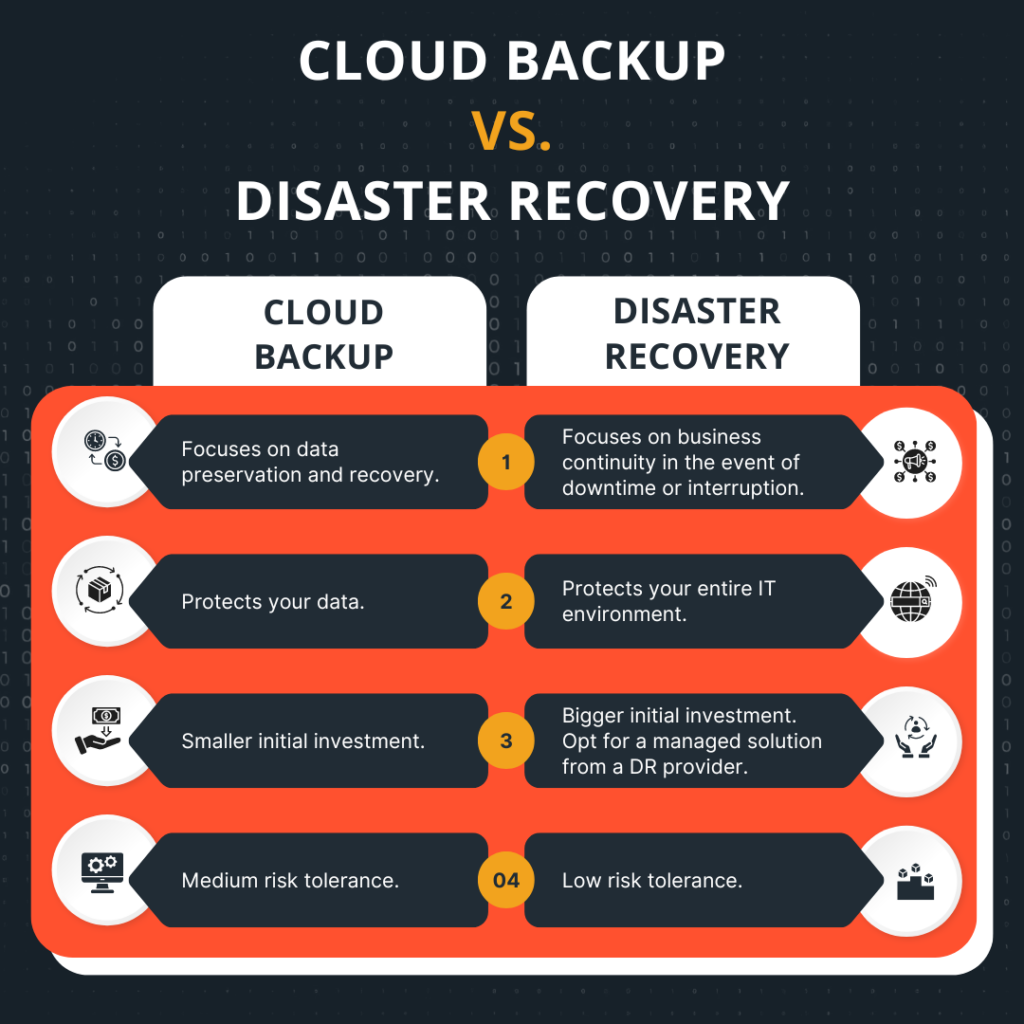Imagine this: a sudden power outage throws your entire office into darkness. Servers go offline, critical applications grind to a halt, and productivity plummets. Such disruptions can have significant consequences on businesses of all sizes, impacting everything from customer service to financial records. This can result in loss of revenue, productivity, and even reputational damage. That’s where Disaster Recovery as a Service (DRaaS) comes to the rescue. But what is DRaaS?
Breaking Down DRaaS:
Simply put, DRaaS is a cloud-based solution that helps organisations prepare for and recover from unexpected events that disrupt their IT operations. It achieves this by:
- Disaster Recovery: This refers to the process of restoring IT systems and data to a functional state after a disaster or unplanned downtime.
- As a Service (aaS): This signifies that DRaaS is delivered and managed by a cloud provider, eliminating the need for you to invest in and maintain your own disaster recovery infrastructure.
What are Recovery Time Objectives (RTO) and Recovery Point Objectives (RPO)?
- Recovery Time Objective (RTO): This refers to the maximum acceptable amount of downtime your organisation can tolerate after a disaster. It essentially defines the timeframe within which you need to restore critical IT operations to minimise business disruption.
- Recovery Point Objective (RPO): This refers to the maximum tolerable amount of data loss your organisation can accept after a disaster. It determines how recent a copy of your data needs to be for recovery purposes.
How Does DRaaS Work?
- Continuous Backup and Replication: DRaaS solutions continuously copy your data and applications to secure, off-site data centres maintained by the cloud provider. This ensures you always have a recent and recoverable copy of your critical information.
- Recovery and Restoration: Once the primary system is back online, you can seamlessly switch back and resume normal operations. DRaaS providers often offer data recovery capabilities, enabling you to restore specific files or applications to a specific point in time.
- Seamless Failover: When a disaster strikes and your primary IT system is compromised, you can initiate a failover to the DRaaS environment. This essentially involves switching operations to the replicated infrastructure in the cloud. This allows your business to continue functioning with minimal downtime.
Benefits of DRaaS:
- Reduced Downtime: DRaaS allows for a quicker and more efficient recovery process, minimising downtime and potential financial losses.
- Enhanced Business Continuity: By ensuring continuous access to critical data and applications, DRaaS helps businesses maintain operational continuity even during disruptions.
- Cost-Effectiveness: DRaaS eliminates the need for upfront investments in hardware, software, and dedicated disaster recovery sites, making it a scalable and cost-efficient solution.
- Scalability: DRaaS solutions are highly scalable, allowing you to easily adjust your resources based on your evolving business needs.
- Improved Security: DRaaS providers offer robust security measures and data encryption to safeguard the confidentiality and integrity of your sensitive information.
What’s the difference between DRaaS and BaaS (Cloud Backup)?
- DRaaS: Takes data protection to the next level by ensuring business continuity. It provides rapid recovery, system replication, and failover capabilities, catering to organisations with stricter RTOs and RPOs.
- BaaS: Focuses on data preservation and is a cost-effective option for safeguarding critical information. It’s suitable for organisations with less stringent recovery time objectives (RTOs) and recovery point objectives (RPOs).

Choosing between these solutions requires a careful assessment of your business’s specific needs, budget, and risk tolerance. Whether you opt for cloud backup or DRaaS, the key takeaway is that investing in data protection is not just a choice, but a necessity. By doing so, you can ensure that your business is resilient, secure, and ready to face any challenges that come its way.
For a more detailed comparison, read our blog to learn more about the differences between cloud backup and DRaaS.
Is DRaaS the Right Solution For Your Business?
DRaaS is a valuable solution for any organisation that relies heavily on its IT infrastructure and data. It’s particularly beneficial for businesses in industries like healthcare, finance, and e-commerce, where even short periods of downtime can have significant consequences.
If you’re not sure if DRaaS is fit for your SME, read our blog to understand why DRaaS is essential for SMEs.
Considering Implementing DRaaS?
Here are some key questions to ask yourself:
- Complexity of your IT infrastructure: DRaaS solutions can be tailored to meet the specific needs of businesses of all sizes and complexities.
- Compliance requirements: DRaaS providers can help ensure your organisation meets relevant data security and regulatory compliance requirements.
- Budget: DRaaS offers a cost-effective way to implement disaster recovery compared to traditional methods.
By understanding what DRaaS is and how it can benefit your business, you can make an informed decision about whether it’s the right solution to enhance your overall disaster recovery strategy.

